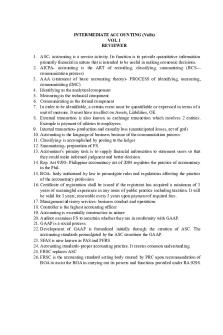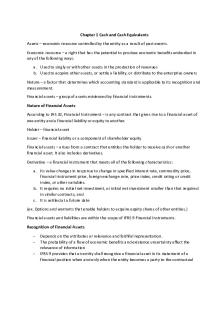Intermediate Accounting Reviewer PDF

| Title | Intermediate Accounting Reviewer |
|---|---|
| Author | Crisel Tactay |
| Course | Accountancy |
| Institution | University of Northern Philippines |
| Pages | 5 |
| File Size | 83.4 KB |
| File Type | |
| Total Downloads | 815 |
| Total Views | 1,036 |
Summary
INTERMEDIATE ACCOUNTING (Valix) VOL 1 REVIEWER ASC- accounting is a service activity. Its function is to provide quantitative information primarily financial in nature that is intended to be useful in making economic decisions. AICPA- accounting is the ART of recording, classifying, summarizing (RCS...
Description
INTERMEDIATE ACCOUNTING (Valix) VOL 1 REVIEWER 1. ASC- accounting is a service activity. Its function is to provide quantitative information primarily financial in nature that is intended to be useful in making economic decisions. 2. AICPA- accounting is the ART of recording, classifying, summarizing (RCS— communication process) 3. AAA (statement of basic accounting theory)- PROCESS of identifying, measuring, communicating (IMC) 4. Identifying as the analytical component 5. Measuring as the technical component 6. Communicating as the formal component 7. In order to be identifiable, a certain event must be quantifiable or expressed in terms of a unit of measure. It must have an effect on Assets, Liabilities, OE. 8. External transaction is also known as exchange transaction which involves 2 entities. Example is payment of salaries to employees. 9. Internal transaction- production and casualty loss (unanticipated losses, act of god) 10. Accounting is the language of business because of the communication process. 11. Classifying- is accomplished by posting to the ledger 12. Summarizing- preparation of FS. 13. Accountant’s primary task is to supply financial information to statement users so that they could make informed judgment and better decision. 14. Rep. Act 9298- Philippine accountancy act of 2004 regulates the practice of accountancy in the Phil. 15. BOA- body authorized by law to promulgate rules and regulations affecting the practice of the accountancy profession 16. Certificate of registration shall be issued if the registrant has acquired a minimum of 3 years of meaningful experience in any areas of public practice including taxation. It will be valid for 3 years, renewable every 3 years upon payment of required fees. 17. Management advisory services- business conduct and operations 18. Controller is the highest accounting officer 19. Accounting is essentially constructive in nature 20. Auditor examines FS to ascertain whether they are in conformity with GAAP. 21. GAAP is a social process. 22. Development of GAAP is formalized initially through the creation of ASC. The accounting standards promulgated by the ASC constitute the GAAP. 23. SFAS is now known as PAS and PFRS 24. Accounting standards-proper accounting practice. It creates common understanding. 25. FRSC replaces ASC 26. FRSC is the accounting standard setting body created by PRC upon recommendation of BOA to assist the BOA in carrying out its powers and functions provided under RA 9298.
Main function is to establish and improve accounting standards that will be generally accepted in the Phil. 27. FRSC is composed of 15 members with a chairman who had been or is presently a senior accounting practitioner. 2 members from Public practice, commerce and industry, academe, government. 28. The counterpart of PIC is the IFRIC in UK 29. IASC- improvement, harmonization and worldwide acceptance and observance of accounting standards 30. IASB replaces IASC. It is a global phenomenon intended to bring about great transparency and a higher degree of comparability in financial reporting; one uniform and globally accepted financial reporting standard 31. Accounting assumptions- serve as the foundation or bedrock of accounting to avoid misunderstanding. known as postulates. 32. Accounting/fiscal period- 12months 33. Fiscal period could either be calendar or natural. If calendar, ends on Dec. 31. if natural, ends on any month when the business is at the lowest or experiencing slack season. 34. Monetary Unit has 2 aspects, quantifiability and stability of peso (current replacement cost is ignored). 35. Sometimes, it is not necessarily valid that peso is stable since there may be instances wherein there is a considerable gap between historical and current replacement cost. Entity should therefore choose whether cost model or revaluation model they will apply to their entire class of PPE. 36. Framework for FS is promulgated by the IASB 37. Framework is the underlying theory for the development of accounting standards and revision of previously issued accounting standards. Assists FRSC, preparers of FS, users and auditors 38. Framework excludes special-purpose report such as prospectuses and tax computation 39. FS largely portray the financial effects of past events and do not necessarily provide nonfinancial information. It shows the result of the stewardship of management or the accountability of management for the resources entrusted to it. 40. Management has the primary responsibility for the preparation of FS. 41. Capacity for adaption or financial flexibility- using the entity’s available cash for unexpected requirements and investment opportunities. It is may be accomplished through raising cash at a short notice through borrowing, sale of securities, disposal of assets without disrupting normal operations 42. Accounting concepts: a. Entity theory= A=L+C (income statement) b. Proprietary= A-L=C (statement of FP) c. Residual equity= A-L-preference/OS=C d. Fund Theory= Fund= Cash inflows-cash outflows (custody and administration of funds)
43. Financial reporting= provision of financial information about an entity to external users. Not just financial statements but also other means of communicating information. It includes non-financial information. 44. Financial reporting objectives: a. provide information useful in investment, credit, and similar decision b. cash flow prospects c. resources and claims to those resources and changes in them. 45. Four principal qualitative characteristics: a. Relevance b. Reliability c. understandability d. comparability 46. Relevance and reliability relate to content and are primary qualities. 47. Understandability and comparability relate to presentation and are secondary characteristics. 48. Relevance is affected by its nature and materiality. It helps users form predictions and confirmations or revision to their expectation. 49. Ingredients of relevance are: a. Predictive value b. Feedback value c. Timeliness 50. Reliability ingredients: a. Faithful representation-actual effects of transaction should be properly accounted for and reported b. Substance over formc. Neutrality d. Conservatism or prudence e. Completeness- Standard of adequate disclosure (notes to FS) 51. Understandability- Users are assumed to have a reasonable knowledge of the economic activities and accounting and a willingness to study the information with reasonable diligence 52. Accounting constraints: a. Timeliness b. Cost-benefit c. Materiality d. Balance between relevance and reliability 53. Materiality- doctrine of convenience. Quantitative threshold 54. An example of trade-off between relevance and reliability is when entity reports quoted equity instruments at 55. Information is relevant but not reliable. On the other hand, if entity reports an instrument at cost, information is reliable but may not be relevant. 56. Installment method- revenue is recognized at the point of collection. Revenue is determined by multiplying the gross profit by amount of collection
57. Immediate recognition of expense- reflects conservatism or prudence. Revenue expenditure 58. Financial performance is determined using 2 approaches: a. Capital maintenance- net income occurs if capital is maintained (single entry) b. Transaction approach- traditional preparation of income statement 59. 2 concepts of capital maintenance: a. Financial capital- based on historical host b. Physical capital-current cost CHAPTER 1 Cash and Cash Equivalents 1. Cash not just include currency and coins but also those that are acceptable by bank for deposit or immediate encashment such as checks, bank drafts and money orders. 2. Cash is measured at face value. Cash in foreign currency is measured at current exchange rate 3. If the financial institution holding the funds of an entity is in bankruptcy or financial difficulty, cash should be written down to estimated realizable value if the amount recoverable is estimated to be lower than face value 4. Excess cash should be invested in revenue-earning investment 5. Deposits in foreign investment which are subject to foreign exchange restriction, if material, should be classified separately among noncurrent assets and the restriction clearly indicated. 6. Details comprising cash and cash equivalents should be disclosed in the notes to financial statements 7. The credit balance in the cash in bank account results from the issuance of checks in excess of the deposits—overdraft 8. Overdraft is not permitted in the Philippines 9. If entity maintains two or more accounts in one bank and one account results in an overdraft, such overdraft can be offset against the other bank account with debit balance in order to show, cash, net of bank overdraft 10. An overdraft can also be offset against the other bank account if the amount is immaterial 11. If the deposit is legally restricted because of a formal compensating balance agreement, the compensating balance is classified separately as “cash held as compensating balance” under current assets if the related loan is short term, otherwise, it is classified as noncurrent investment 12. In banking practice, checks become stale if not encashed within 6months from the time of issuance 13. If stale check is immaterial, it is simply accounted for as a miscellaneous income. Cash Miscellaneous Income 14. If material and liability is expected to continue, cash is restored and liability is again set up 15. Cash short/over Due from cashier Loss from cash shortage
Cash Cash short/over Cash short/over 16. Cash short/over account is a temporary account. When we already know the cause of such shortage or overage, we then cancel d cash short/over account and replace it with the “real cause”. 17. Imprest system- system of control of cash which requires that all cash receipts should be deposited intact and all cash disbursement should be made by means of check. 18. In imprest system, payment of expenses requires no formal entries. Petty cashier generally requires a signed petty cash voucher for such payments and prepares memo entry in the petty cash journal. 19. Petty cash disbursement should be replenished only by means of check and not from undeposited collection 20. If not replenished, the entry is to state the correct cash fund is: Expenses Petty cash fund 21. Under fluctuating fund system, checks drawn to replenish the fund do not necessarily equal the petty cash disbursement. Expenses are immediately recorded and PCF fluctuates from to time....
Similar Free PDFs

Reviewer for Intermediate Accounting
- 106 Pages

Intermediate Accounting Reviewer
- 5 Pages

Intermediate- Accounting
- 6 Pages

Intermediate accounting
- 3 Pages

Intermediate accounting
- 84 Pages

Intermediate Accounting
- 7 Pages

Intermediate Accounting
- 12 Pages

Accounting reviewer
- 7 Pages
Popular Institutions
- Tinajero National High School - Annex
- Politeknik Caltex Riau
- Yokohama City University
- SGT University
- University of Al-Qadisiyah
- Divine Word College of Vigan
- Techniek College Rotterdam
- Universidade de Santiago
- Universiti Teknologi MARA Cawangan Johor Kampus Pasir Gudang
- Poltekkes Kemenkes Yogyakarta
- Baguio City National High School
- Colegio san marcos
- preparatoria uno
- Centro de Bachillerato Tecnológico Industrial y de Servicios No. 107
- Dalian Maritime University
- Quang Trung Secondary School
- Colegio Tecnológico en Informática
- Corporación Regional de Educación Superior
- Grupo CEDVA
- Dar Al Uloom University
- Centro de Estudios Preuniversitarios de la Universidad Nacional de Ingeniería
- 上智大学
- Aakash International School, Nuna Majara
- San Felipe Neri Catholic School
- Kang Chiao International School - New Taipei City
- Misamis Occidental National High School
- Institución Educativa Escuela Normal Juan Ladrilleros
- Kolehiyo ng Pantukan
- Batanes State College
- Instituto Continental
- Sekolah Menengah Kejuruan Kesehatan Kaltara (Tarakan)
- Colegio de La Inmaculada Concepcion - Cebu







